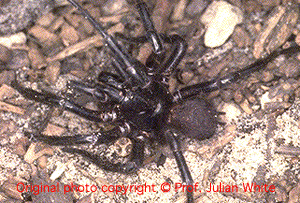
Used for neutralising systemic envenoming by members of the Australian funnel web spider group. It is made from rabbit IgG. Each ampoule contains 125 units of neutralising capacity against the target venoms. This is a freeze dried preparation. Re-constitute with approximately 6.3mL of Water for Injections BP. The immunising species is the Sydney funnel web spider.
CSL Funnel Web Spider Antivenom was originally developed to treat cases of bites by the Sydney funnel web spider, but has proved effective in bites by a variety of other species of funnel web spiders as well. There are at least 35 species of funnel web spiders, in 2 genera, Atrax and Hadronyche. All are medium to large, robust spiders, mostly dark or black in colour, with stout legs and large fangs. Both males and females build silk tube retreats, usually in the ground. Males leave these retreats in search of female mates, a process which may increase the chance of adverse interaction with people, as the wandering males may get underfoot, into shoes, boots or clothing left on or near the floor. There is experimental evidence suggesting that this antivenom may also be effective in treating severe envenoming by mouse spiders (Missulena).

Funnel web spiders have a wide distribution throughout south east Australia, including Tasmania. However, species so far proven dangerous to humans have a more limited range, largely limited to eastern parts of NSW and SE Queensland. The only proven killer, the Sydney funnel web spider, is restricted to the Sydney region and adjacent areas to the north and south of the city, including Gosford.
Funnel web spider venom is multicomponent, but a protein toxin, robustoxin, is considered to be the principal component responsible for severe envenoming in humans. It is interesting to note that most mammals are relatively unaffected by funnel web spider venom, but humans are very sensitive. Robustoxin causes stimulation of the nervous system at a variety of synapse types, with rapid and devastating effect.
Despite its fearsome reputation, there are only 14 recorded deaths due to funnel web spider bite, and experience has shown that many bites do not result in significant envenoming. However, when the spider does inject a dangerous quantity of venom, the effects can be rapid and severe, and death within an hour may occur. The bite is usually painful, both due to large fangs and acidic venom and the spider is usually seen. If envenoming occurs, it will develop early, starting with tingling around the lips, twitching of the tongue, then profuse salivation, lachrymation, sweating, piloerection and muscle twitching/spasms. Hypertension and tachycardia occur, and respiratory distress due to rapid development of pulmonary oedema, which may be very severe and potentially lethal. In the early stages it may be mistaken for organo-phosphate poisoning. Convulsions may occur.
As with most antivenoms, CSL Funnel Web Spider Antivenom should only be given if there is clear evidence of envenoming. See potential contraindications. It should be given intravenously, through a drip set. Prior to commencing antivenom therapy, make sure everything is ready to treat anaphylaxis, should this occur, though with envenoming by funnel web spider anaphylaxis is unlikely because of the "catecholamine storm" effect of the venom. Specifically, have adrenaline ready to give, though it is very unlikely to be required.
The use of adrenaline as pre-treatment when using antivenoms is still being debated. The risk of anaphylaxis varies from antivenom to antivenom. It is recommended that the Product Information be read before use and if necessary contact be made with a specialist in the field.
At the first sign of systemic envenoming due to suspected funnel web spider bite, it is advisable to give 2 vials of CSL Funnel Web Spider Antivenom, and be prepared to give another 2 to 4 vials. If envenoming is already severe, start with 4 vials. Any patient who has been bitten by a spider which is possibly a funnel web spider, and who develops excessive salivation or lachrymation or twitching of the tongue or respiratory distress should be assumed to have systemic envenoming and treated with antivenom.
If there has been an initial response, followed by later return of respiratory distress without other features of envenoming (such as salivation and lachrymation), it is quite possible this is due to further venom entering the circulation, and more antivenom may be needed. Another possible explanation in this situation, at least in children, is that they are developing pulmonary oedema due to overload of IV fluids. Unless the latter is clearly the explanation, err on the side of further venom effect. If the respiratory impairment is mild, it might be reasonable to try a diuretic, such as frusemide, as first line therapy, but if this does not work, or respiratory distress worsens or is severe, use antivenom.
If there is either a sudden fall in blood pressure or bronchospasm, after starting the antivenom infusion, then temporarily stop the antivenom and give adrenaline by subcutaneous injection(1:1000 solution), give 100% O2 and IV fluids (such as Haemaccel®, but be cautious of fluid overload).
Once the untoward antivenom reaction is thus controlled, cautiously recommence antivenom infusion.
Adrenaline dose; for adults give 0.5mL (0.5mg) initially; for children give 0.01mg/kg initially. Repeat as necessary and try IM injection if no response to SC injection. If bronchospasm is the major problem, try nebulised adrenaline, 2mL of 1:1000 solution.
Any patient who has received antivenom may develop serum sickness, from 4 to 14 days later, though this appears to be rare with CSL Funnel Web Spider Antivenom. Before leaving hospital, they should be advised of the symptoms of serum sickness, such as rash, fever, joint aches and pains, malaise, and told to return immediately for review and probable commencement of oral steroid therapy. If there was major envenoming, organise follow up. This is usually not necessary for minor envenoming.